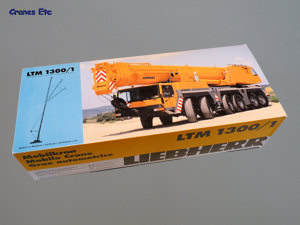 | | Typical Liebherr box style. |  | 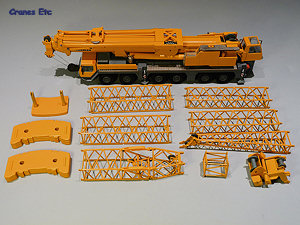 | | The parts out of the box. | 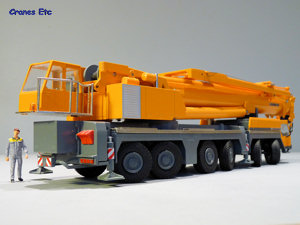 | | Cab stowed for transport. | 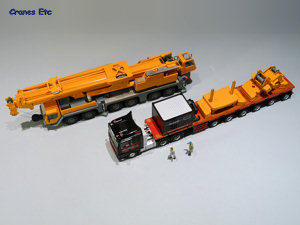 | | Paired with a Nooteboom ballast carrier. | 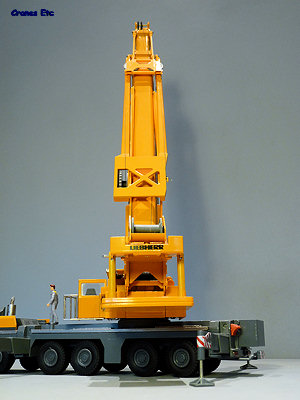 | | Superlift folded down out of use. | 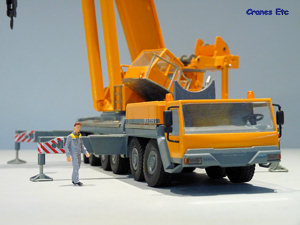 | | Driving cab details are plain. | 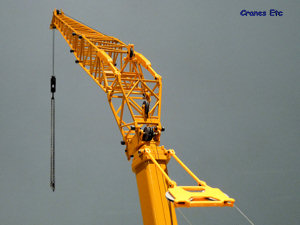 | | Good structure on the fly jib. | 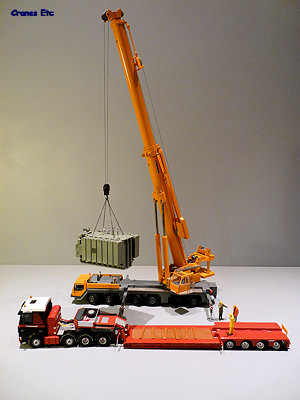 | | Lifting a Smit Transformer. |
| At the time of the review this is the largest Liebherr mobile crane modelled in diecast metal. It is a model of a 300 tonne capacity 6 axle crane. To see pictures of the real machine click here.
Packaging
The model is provided in a Liebherr picture sleeve box which encloses two polystyrene trays. Each tray holds a selection of pieces comprising fly jib sections and the counterweight, as well as the crane itself. Instructions are provided in German and are straightforward to follow. There was no damage on the review model.
Detail
The wheels of the carrier are treaded rubber tyres mounted on plastic hubs. All hubs are the same rather than having the different hub that is present on the fixed axle of the original. At the front of the carrier, the cab has plastic headlight lenses set into the bumper, although there are no windscreen wipers. The doors have wing mirrors and there are two beacon lights on the roof. Inside, the cab is detailed with seats, steering wheel and instruments. Unfortunately there is no loop at the front to hook onto when the crane is in transport mode.
The rest of the carrier is almost all metal and is very solid. Covers to the main drive engine have good detailing on the grilles and the main flat surfaces have a textured surface and cast in ladders. At the rear there is a tool box and wheel chocks and the lights are painted. The outriggers are two stage with the outer section being in diecast metal. The inner 'sleeve' section is plastic but they give the impression of being able to support the weight of the model. The outrigger jacks are the usual screw variety although the thread is perhaps too small to trust with supporting the crane when erected with the jib at a big reach.
The crane is very good. The driving cab is an excellent 'swingaway' type with a textured walkway and convincing metal handrails. A beacon light is attached in front of the cab which is used when the crane is being transported. The cab is well detailed internally. Detailing of the rest of the crane body is of a high standard and this is enhanced by the fact that it is all metal. Textured surfaces, ladders and handrails are all executed very well and a pair of small metal tanks add to the look.
The counterweight assembly is excellent. It is fully fabricated in pieces as in the original and consists of the hanger and first slab as two parts, and a further six slabs make up the rest of the counterweight. Each slab is beautifully cast and includes lifting lugs so pieces can be realistically slung from the crane hook. On top sits the luffing winch assembly which has two winch drums available to control the luffing and an extra hook. All pieces fit smoothly together and are then pinned to the crane body.
The main boom is a hefty piece of work like the original. The five section telescope is well cast and the fit is very good. The superlift assembly is a substantial metal component which is restrained to the bottom of the boom by a pair of pendants. These are plastic and although they work effectively they are inferior to metal construction. The superlift attaches, and therefore applies tension, to the top of the third section of boom. Here the luffing bridle and pulleys are all plastic and the same comment applies as for the pendants. The boom head is a robust metal arrangement with multiple plastic pulleys which are a tight squeeze and not therefore free rolling.
The fixed fly jib comes in seven separate sections and permits a variety of different lengths to be erected. The casting tolerances are excellent as even at its longest, the jib is true and rigid. It is all metal except for the ratchet pieces which allow the jib to be fixed to different offset angles. At the tip of the fly jib the head is cast to accept a roller for use when erecting the jib in a luffing situation, but the roller is not provided with the model. Only a single pulley metal hook is provided which although it is good, it does not do justice to the model and a larger multi pulley hook would be more appropriate.
Features
The front three pairs of axles are linked and all steer together. The rear axles are also linked together with axle four being fixed. A good hard lock can be obtained on the steering axles. The two stage outriggers can be extended and lowered as desired.
On the crane body the swingaway cab can be rotated to the rear of the crane to be stowed during transport. In use the cab also fully tilts to give the operator a comfortable view of high lifts.
All the usual crane functions operate. Elevating the boom requires strength because the twin cylinders are stiff to ensure the boom does not sag. The superlift unfolds to operate if required and can tension the boom noticeably. Operating the winch is done by thumbing the drum directly which avoids unsightly winding handles.
The lattice fly jib can be fixed in a number of different lengths and can also be fixed straight or at two different angles if an offset is required.
Quality
Both the look and weight of the model give the impression of a very solid piece of model engineering with all functional pieces working well. The quality of castings is very good with ample details. Paintwork and lettering is also of a high standard.
Price
This is a very good quality large model and the inclusion of the multi-piece fly jib makes it good value for money.
Overall
Conrad have produced an model which looks great in transport mode and is very impressive when posed with the boom fully extended and fly jib attached. It also can be displayed loading the counterweight slabs off a ballast trailer without taking up too much display space and looks great. There are two improvements which would enhance the model. The provision of a decent large hook can be done easily with hooks Conrad make already. A luffing attachment for the fly jib would extend the range of display options available but Liebherr did not commission Conrad to make one.
Footnotes
The model appeared at the 2001 Nuremberg Toy Fair. At the 2002 Nuremberg Toy Fair a version in 'Schmidbauer' livery was displayed. The model number of the real crane was later changed to an LTM1300-6.1 to suit the Liebherr numbering system. YCC Models have produced a luffing jib attachment for the model.
|
| |
| 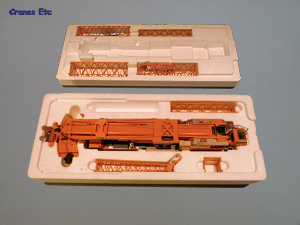 | | The model in the trays. | 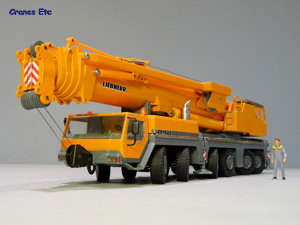 | | Very good lock on the steering. | 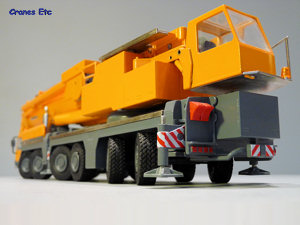 | | Fairly simple detailing, but strong lines look good. | 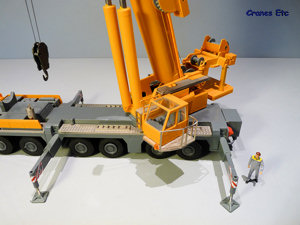 | | Two stage outriggers. |  | | Tilting crane cab. | 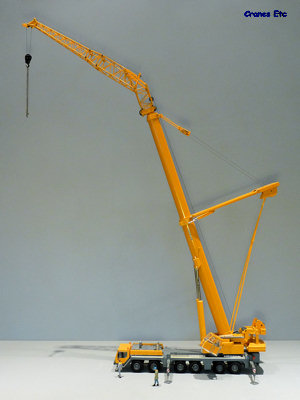 | | Rigged with a short fly jib and with the superlift working. | 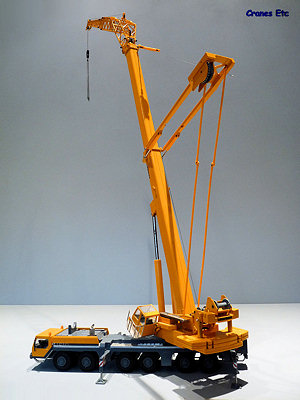 | | Superlift opened. |
|

